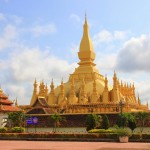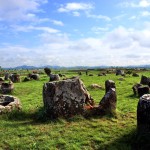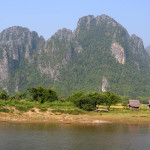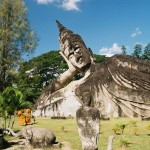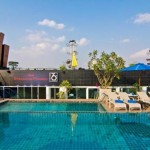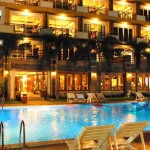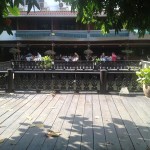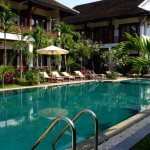Laos Holiday and Festivals
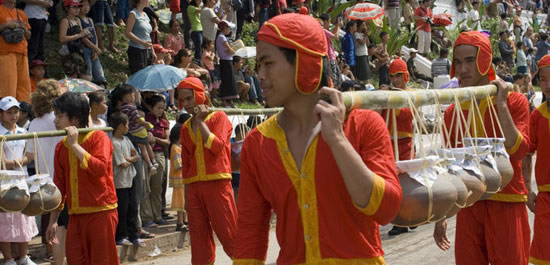
Lao Festivals are usually linked to agricultural seasons or historical Buddhist holidays. The biggest celebration, New Year, interestingly enough takes place in mid-April, and this is also true of Thailand, Burma, Cambodia, and among the Dai people of Yunnan, China. Boon Bang Fai (the rocket festival) takes place a month later in May, when more significant rain showers should materialize. This is an animist celebration with plenty of processions, music and dancing, accompanied by the firing of bamboo rockets to prompt the heavens to send rain. The week-long Tat Luang Festival in Vientiane in November has the whole repertoire of fireworks, music and parades.
Bun Pha Wet (January)
Falling on different dates each year – people exchange invitations with friends and families in different villages to join in their celebrations – this festival is a commemoration of the Jataka, the life story of Lord Buddha as Prince Vestsantara. The story is recited in temples throughout the country and this is considered a particularly auspicious time for ordination as a monk.
Magha Puja (February)
Held on the night of the full moon, this festival commemorates the original teachings of Lord Buddha given to over a thousand monks who came spontaneously to hear him speak. The festival is marked by grand parades of candle-bearing worshippers circling their local temples, merit making, and much religious music and chanting.
Vietnamese Tet & Chinese New Year (February)
Celebrated in Vientiane, Pakse and Savannakhet by the larger Vietnamese and Chinese communities who close their businesses for several days during this period, this festival combines visits to temples and merit making with noisy parties, and hundreds of strings of firecrackers.
Boun Khoun Khao (March)
A harvest festival celebrated at local temples
Boun Pimai (April)
Lasting several days in mid-April, this is the celebration of the Laos New Year and is a combination of merriment and meditation. Similar to festivals at this time of year in other Southeast Asian countries – particularly Thailand – Boun Pimai is celebrated with parades, dancing, singing and enthusiastic water throwing. The religious aspects of the festival are most apparent in Luang Prabang, where Buddha statues are worshiped with water pouring ceremonies. Temple compounds are further decorated with small sand Stupas, offered as merit towards good fortune and health.
Labour Day (1st May)
public holiday
Visakha Puja (May)
Chanting, religious instruction, and candlelit processions highlight this temple festival in celebration of the birth, enlightenment and death of the Buddha.
Boun Bang Fai (Rocket Festival) (May)
With its origins in pre-Buddhist rain-invoking ceremonies, this festival now coincides with the Laos Visakha Puja celebrations. Parades, songs, dances and partying all lead to an explosive climax as huge, ornate, homemade bamboo rockets are blessed and fired into the skies to invite the rains. Rocket-makers earn both merit and honour if their creations fly high. This dramatic festival is also celebrated in Northeast Thailand.
Children’s Day (1st June)
Public Holiday
Khao Phansaa (July)
Marking the beginning of the three-month Buddhist Lent, which commences at the full moon in July and continues until the full moon in October, this is considered a particularly auspicious time for Lao men to enter the monkhood and is marked by numerous ordination ceremonies.
Haw Khao Padap Din (August)
Devoted to remembering and paying respect to the dead, it is marked by the macabre ceremony of exhuming previously buried bodies, cleaning the remains, and then cremating them on the night of the full moon. Relatives then present gifts to the monks who have chanted on behalf of those who have passed away.
Awk Phansaa (Awk Watsa) (October)
Marking the end of the three-month Buddhist Lent on the day of the full moon. Monks are at last permitted to leave the temple and are presented with gifts. One particularly beautiful aspect is Lai Hua Fai. On the eve of Awk Phansaa people gather at the nearest body of water to release dozens of small banana-leaf boats decorated with candles, incense and small flowers, in a celebration similar to Thailand’s Loy Krathong Festival.
Bun Nam (water festival) (October)
In riverside towns such as Vientiane, Luang Prabang and Savannakhet, the highly competitive Bun Nam boat races (reua suang) are held during the same time as Awk Phansaa. Smaller communities sometimes hold these races on National Day on 2nd December
Boun That Luang (November)
Though celebrated at many temples around the country, this festival is traditionally centered at That Luang in Vientiane. Fairs, beauty contests, music and fireworks take place throughout the week of the full moon, and end with a candlelight procession (wien thien) around the temple of That Luang.
Lao National Day (2nd December – public holiday)
Streets strewn with national flags and banners, processions, parades, and speeches are the highlights of this celebration for the victory of the proletariat in 1975.
Lao New year – Pii Mai or Song Kran
.jpg)
The origins of this momentous holiday is difficult to pin down – either from Yunnan China, or possibly, India. It is actually the clebration of the vernal equinox, much like the origins of Easter and the Indian Holi festival. In southeast Asia, the date of Pii Mai probably has a seasonal basis, since it coincides with the beginning of the agricultural season and the hydrological water year (when the monsoon winds arrive bringing the first sprinkling of showers). Houses are cleaned, offerings are made in wats and everyone gets dowsed by water.
Cleansing to get ready for the approach of a new year is a very instrumental part of the celebrations, and water is a common theme. The first ceremony consists of washing Buddha images with holy jasmine water. The there is the rot nam, whereby the junior members of the family anoint and sprinkle water on their elders. For tourists, the most noticeable and memorable custom is the dousing of passerby with buckets of water, and hardly anyone walking around at this time can avoid ending up sopping wet.
The New Year celebration symbolizes the cleansing of the past year in order to bless the year to come. This celebration serves to eliminate all of the evil influences that had assimilated during the previous year and guarantee good fortune for the next year.
Hmong New Year
.jpg)
Hmong New Year is more closely associated with Chinese New Year, and the time of celebration is either January or February (the first lunar month) as compared to April for Pii Mai (fifth lunar month).
New Year sacred rites include the traditional sweeping of each house to drive out all the evil spirits and misfortunes of the past year, during which a rooster is sacrificed and blessings are pronounced for health and prosperity for a particular household during the New Year These rituals are all practiced within each individual household. However, one major ritual is performed by all of the heads of househols of the communities.
The performance of the Ntoo Xeeb is held on the first day of January and promotes the welfare of the entire village. Ntoo Xeeb translates into trees that have roots above the ground The purpose of this ritual is to call forth the Ntoo Xeeb spirit to protect the health and welfare of the people in the village. The villagers take the site of the ritual into special consideration because it must be a sacred well-protected location. After cleaning and enclosing the ritual site, it is time for the actual ritual to take place. Only the head of each household is allowed to be present. First, they make offering of tea and rice wine to the four kinds of forest spirits. Next, the leader ritually removes branches from the gate opening. The purpose of the chant is to invite the spirit to the ceremony and ask it to accept the offerings and in turn provide them with its blessing for the year The last part of the ceremony consists of the men rushing to the altar and placing incense and candles on it. They all must ask the spirit for whatever it is that they want.
Probably the most popular activity for younger people, is the ball throwing courtship ritual, where young men and women stand in two lines facing each other, and toss a clothball back and forth.


